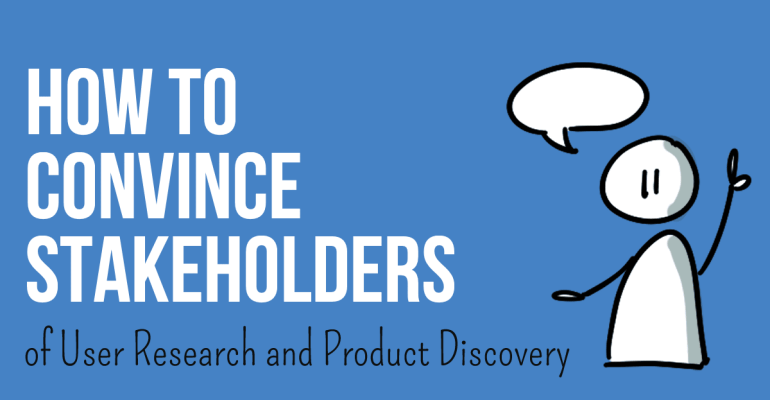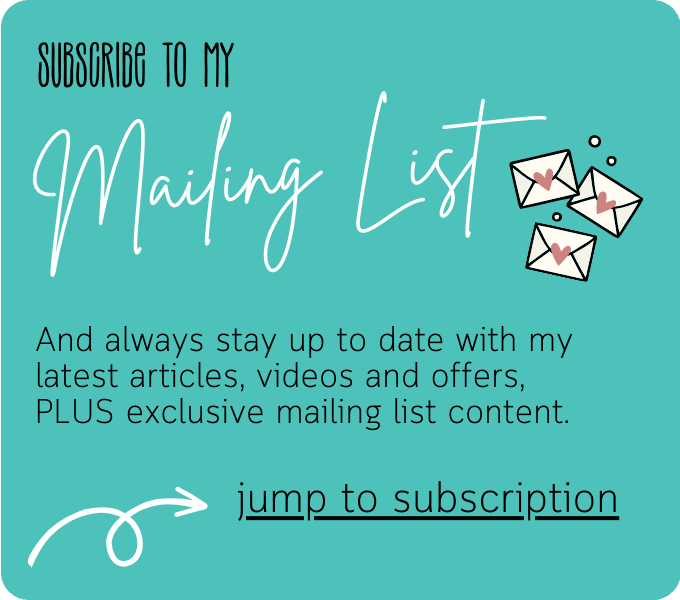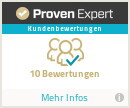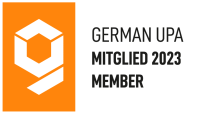How to Convince Stakeholders of User Research and Product Discovery
30. September 2022 2023-09-28 11:51How to Convince Stakeholders of User Research and Product Discovery
This week, I gave a short talk on Product Discovery and UX Research at a UX Meetup, and the following day we had an excellent fishbowl session on the same topic. We had great discussions and many great questions at both events.
One participant shared her main insight, which inspired me to write this article. Thank you very much for the inspiration 🙏🏻 Stay tuned until the end. Otherwise, you’ll miss it!
The hustle is real
Many of you struggle in your daily work to convince stakeholders and other people of the importance of user research and using frameworks to make informed decisions such as product discovery.
Who are these people that need to be convinced? They could be colleagues, members of your product team who are not experts in the field, or even other designers with a completely different approach or understanding of processes and methods. It can be internal stakeholders, such as other departments that have requirements for you, or even people from leadership or management levels who have budgetary responsibility and from whom you need approval to be able to implement your desired processes.
But it can also be your clients, for instance, if you work in an agency or service set-up. And here, too, it’s about budgets because a project is supposedly cheaper if you leave out the elaborate research part. „We already know enough about our users.“ – could then be one of the clients‘ arguments. In this case, there is another problem: competitors with different working methods may exert additional pressure through lower prices.
The problem with convincing
But how can we meet these critical stakeholders, and what possibilities do we have to convince them? Let’s take a quick look at where exactly the problem lies. And, of course, as is so often the case, it lies in our brains.
When we receive new information, it is first evaluated by our brain. And the further it deviates from our own assumptions and our own opinions, the less weight we attach to this information. Our own experiences and beliefs serve as a reference. And the more experiences we have, e.g. on a particular topic, which we also evaluated as successful, the less we will be convinced by deviating information.
Use research methods to connect with them
So with arguments, no matter how good they are, we usually don’t get anywhere. But that is no reason to throw in the towel because there are ways to become more convincing. The first thing is our charisma and how we come across to our counterparts. We should appear as positive, self-confident and assured as possible. Not arrogant but also not insecure, as always: the golden mean.
Of course, finding out who we are talking to is essential. What are this person’s problems and challenges? Why does he or she have this point of view? What are the reasons behind it?
Oh, that sounds like user interview questions. That’s precisely it. We should address this issue with our board resources. First, we should understand our „target group“, preferably even before we sit in the crucial conversation.
After all, the reasons why a person is opposed to, e.g. new ways of working can be manifold. Bad experiences, fears, pressure from above, impatience, lack of money or time, and other circumstances can be the triggers. Understanding what preoccupies and moves our counterpart is the first step toward a mutual solution. An honest and sincere interest in the other person radiates authenticity and trustworthiness and gives them the feeling that we don’t just want to push our thing.
Communication as a tool
We should also express what we want to convey through our body language and facial expressions: Openness, sincerity, and positivity. This includes, for instance, not folding your arms in front of your chest, which looks closed and rejecting, and a friendly smile. But beware: a false smile is recognised, even unconsciously, and tends to generate scepticism in the other person.
It is the same with our language. We should try to communicate as positively as possible. In other words, the statements we make and the thought spaces we want to create should be embedded in a positive framing. Let’s take the two antonyms, war and peace, for example. We can make similar statements with both, but they entail entirely different feelings. For instance, if I say, „I don’t want war any more.“ This sentence brings the heavy, sad sense of war – and there certainly are situations in which we want to create precisely this feeling. But if we want to create a positive frame, we should say, „I wish for peace.“
Showing personal advantages
So, once we have managed to create a good atmosphere – built rapport – and know how best to appear, it is, of course, about the content we communicate.
„I think we should do such and such.“ Won’t work.
Depending on who my counterpart is and what the background is for their point of view, one way is to show with very concrete examples what benefits we think our approach has for them. So: what would improve in this person’s life if we tried our suggestion? To do this, we first need to know what is not good in this person’s life right now.
Perhaps we have found out (see above) that this person is stonewalling because they are getting a lot of pressure from above. They may be under a lot of time pressure and regularly get in trouble when things are not finished on time or go wrong and are afraid that more user research or a product discovery will take even longer and lead to more trouble.
Of course, we also know that product discovery takes time and thus takes longer. But we are convinced that it will lead to better-informed decisions, which will also give this person more security and, over time, take away the fear of making mistakes. We can also show this person that they will complete more successful projects through our approach, which will significantly improve their standing with their managers.
The aha-moment
Maybe you are already doing all these things, but your counterparts are still stonewalling and insisting on their positions and old, supposedly more favourable approaches. Then perhaps the takeaway of the visitor to my talk mentioned above will help you.
In it, I showed Laura Klein’s matrix, which she uses in her framework to prioritise assumptions. (By the way, I found this matrix in the great book „Strong Product People“ by Petra Wille).
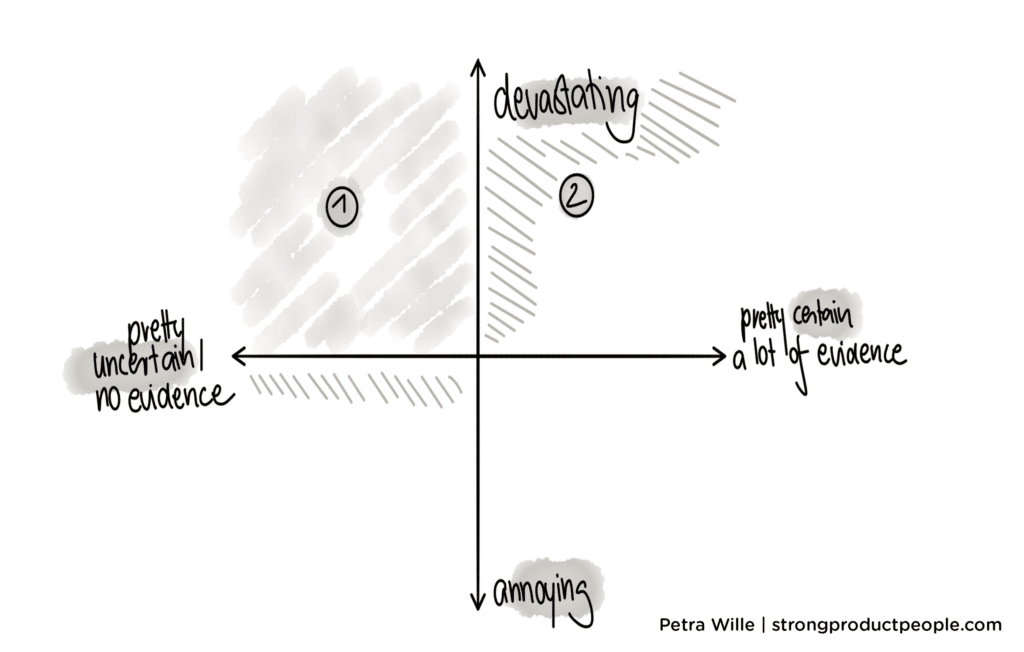
To use this matrix, you first must collect assumptions, e.g. on post-it notes, about the product idea or project you are working on. Unfortunately, I cannot go into this in more detail here. You then take each of these assumptions and ask, firstly, „If this assumption is wrong, how bad is that for our venture?“. The worse it would be if the assumption turns out to be wrong, the higher the post-it is hung.
The second question is: „how sure are we that this assumption is true in the first place?“ And the less sure we are, because we may not have any evidence for it yet, the further the assumption is hung to the left.
So, the upper left quadrant of the matrix collects all the assumptions we are not sure are true and for which it would be disastrous if they were false because then our endeavour would fail.
The mentioned visitor now had the following aha moment: she reported that they would already collect assumptions with the customers in workshops today but would cluster them differently in her work at a service company. With Laura Klein’s matrix, however, they would now be able to show other people very clearly how risky their assumptions might actually be.
I hope that this new method is a good lever and hope to see reports from her once she has tried it out a few times 😃
Because she is right, of course. As described at the very top, our brains work so that we are usually very convinced of our assumptions, even without having facts to back them up. Only when we are forced to think about – and argue in front of others – what data these assumptions are actually based on that we realise that they are perhaps more beliefs than facts.
If our stakeholders now also actively think about and decide for themselves how bad a misconception would be for their venture, this can be the decisive eye-opener moment to convince them of more user research and the use of Product Discoveries.
Conclusion
I am convinced that understanding the other person, using positive language, pointing out concrete improvements, and letting the other person see the weaknesses in their own approach can help you to bring user research and frameworks like product discovery to the people. Feel free to write to me about how you see it or if you have tried my tips and how they work for you.
This article has become much longer than I wanted it to be, yet there is still so much information, tips and tricks missing that I would have liked to include. But luckily I can publish a new article every Friday. So stay tuned and look forward to the next input 😉
Relevant Resources
Klein, L. (2013). UX for Lean Startups: Faster, Smarter User Experience Research and Design. O’Reilly.
Wille, P. (2020). STRONG Product People. Petra Wille. https://www.strongproductpeople.com/


